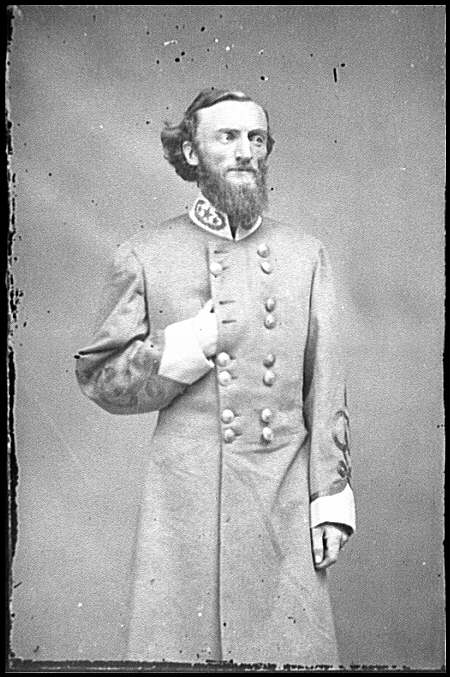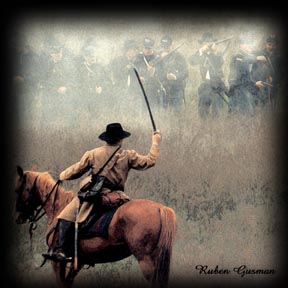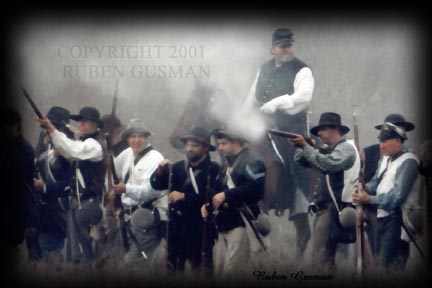| BATTLE OF CANE HILL ARKANSAS |
 |
| Battle Summary - November 28, 1862 |
| Description: In October 1862 Brigadier General James G. Blunt's division of the Army of the Frontier advanced into north-west Arkansas and halted near Old Fort Wayne, on the border of the Indian Territory. In late November, Major General Thomas Hindman detached Brigadier General John S. Marmaduke with the First Corps cavalry from Van Buren north to occupy the area. They were to gather food for the army and prevent Blunt from uniting with the Federals in winter camps near Springfield, Missouri. They rode toward the agricultural area of Cane Hill, a long, low ridge on the northern side of the Boston Mountains. Under Marmaduke's command also were Colonel Stand Watie's 1st Cherokee Mounted Rifles. General Marmaduke, noted for his night marches, moved his divisions at sundown through Van Buren along the rugged road and streams of the Boston Mountains into the valley of Cane Hill. He set up camp there on November 26. Brigadier General Blunt was afraid that the confederate forces would advance north. He sent a scouting expedition to locate the southern forces. The scouting expedition returned and Blunt was told that Marmaduke was just thirty-five miles south of Blunt's position. Blunt, with his whole available force of three brigades, four batteries and six mounted howitzers advanced to meet Marmaduke's command. |
| Other Names: Cane Hill, Boston Mountains Location: Washington County, Arkansas Campaign: Prairie Grove Campaign (1862) Principal Commanders: Brig. Gen. James G. Blunt [US]; Brig. Gen. John S. Marmaduke [CS] Forces Engaged: Department of Missouri [US]; I Corps, two cavalry brigades [CS] Estimated Casualities: 475 Total (US 40; CS 435) Result: Confederate Tactical Victory |
 |
 |
| Map Design By James Acerra Ace's Artwork |
The notorious Quantrill and his band were engaged in the fight. Some of Quantrill's men were killed and others taken prisoners. |
| William Quantrill |
 |
 |
| Colonel Joseph Shelby |
 |
 |
 |
 |
 |
| 13th Kansas The 13th Kansas had marched to Camp Babcock at Lindsey Park, Arkansas on November 11th. They remained there, subsisting mainly on the country while they awaited the arrival of supplies from Ft. Scott. The supplies arrived on the night of the 26th. Three days' rations of hard bread and meat was issued, and the men were ordered to supply themselves with eighty rounds of ammunition. They were prepared to attack the rebel force of Colonel Joseph "Jo" Shelby and Colonel Emmett MacDonald under the command of General Marmaduke. Early on the morning of the 27th the whole command moved in the direction of Cane Hill where Marmaduke had taken position with his cavalry, two howitzers and a battery of artillery. At 7 o'clock that evening they bivouacked within ten miles of the hostile encampment and on the following morning, November 28, they attacked. |
| The first union advance consisted of two hundred Kansas cavalry, two mounted howitzers and Rabb's Battery. The main body of the army was still some miles in the rear. The advance passed down a gorge and encountered a small force set to watch the passage. They drove the force before them; emerging from the gorge to find the enemy drawn in battle lines upon some elevated ground on their right with their guns in battery. Rabb's pieces were soon in position. Fierce cannonding ensued for the next hour while the main union body hastened forward. It was a running battle extending over miles of mountains and creeks, complete with hand-to-hand sabre charges and artillery assaults. The Confederate forces fought a delaying action to protect their supply trains; gradually giving ground. Colonel Shelby lead the rear-guard tactic of moving his cavalry back one group at a time with the first dashing past the intervening ones and becoming the last, which meant constant fighting during the withdrawal. They retreated from Cane Hill; making stands at Boonsboro and Russellville. Marmaduke drew the Union Army into a narrow ravine on the Cove Creek Road. The Confederate forces were finally compelled to retreat into the timberland and brush roads. This battle raged for 9 hours and continued for a distance of fifteen miles. |
| Memorable Incidents: Colonel Shelby had four horses shot out from under him while leading his rear-guard tactic. |
A participant in the battle describes the scene: "From one hill to another, through every deep ravine, up and down mountains and through the woods they fled, ocasionally making a stand in some masked place, until charged and shelled out. Thus the battle continued, the retreat and the pursuit, from ten in the morning until dark. Almost every rod of ground was fought over for a distance of ten miles. Both armies were exhausted. Cavalry regiments dismounted and fought through the brush. Artillery horses dropped in their harness, and men would sieze the ropes and drag the guns forward. The closing scene was between sunset and dark. The enemy made a stand in a deep ravine. Our howitzers had not yet come up. Our men, impatient, made a charge, cavalrymen on foot, with sabres and pistols, infantry with bayonets, and Indians with rifles in the very thickest of the woods. The cheering of the white men, the shrill war whoops of the Indians, the clashing of the sabres, and the incessant roar of small-arms, converted this remote gorge into a perfect Pandemonium." At nightfall the action was ended. The Federals bivouacked on the battle field for the night and returned to Cane Hill the following morning. The Confederates forces returned to Van Buren. Marmaduke's withdrawel was a setback to Confederate plans to recaptue north-west Arkansas. |
 |
| Stand Watie |